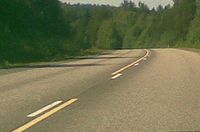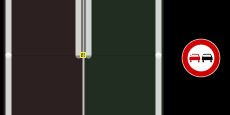Key:overtaking
| Description |
|---|
| Overtaking restrictions as signposted or painted on the ground |
| Group: restrictions |
| Used on these elements |
| See also |
|
| Status: in use |
| Tools for this tag |
|
Using the overtaking=* tag to specify the legal status of overtaking (also known as passing) on a section of road, which may either be indicated by markings on the road or by a traffic sign. Overtaking means to catch up with and move in front of another vehicle or person while traveling in the same direction.
Values
- overtaking=no: overtaking is not allowed in both directions
- overtaking=caution: overtaking in both directions should only be undertaken with caution
- overtaking=both: there are no legal restrictions on overtaking.
- overtaking=yes: overtaking is allowed in all legal directions. May be more suitable than 'both' for oneway streets
- overtaking=forward: overtaking is allowed when driving in the direction of the way but not in the other direction
- overtaking=backward: overtaking is allowed when driving against the direction of the way but not in the other direction
- overtaking:forward=*: Used with the above values to define a restriction that applies only in the forward direction
- overtaking:backward=*: Used with the above values to define a restriction that applies only in the backward direction
Data consumers should not assume a default value. In the absence of an overtaking=* key, the likely value for a two-lane road depends on the region.
How to map
The overtaking restriction should start where a solid centerline begins or at the location of a traffic sign, and not at the location where preliminary notice markings (dashed yellow centerline or "return to own lane" curved arrows) begin. Where the restrictions for both directions change within some tens of meters (as in the example on the right), it is often not necessary to split the way twice but only at their midpoint.
Make sure to cut the way at the beginning and end points of the restriction before applying the tag so that it does not extend beyond the actual stretch of road where the restriction applies.
Overtaking by specific vehicles
For signposted "no overtaking in a hgv" restrictions, the most likely tag to use would be overtaking:hgv=*.
Regional Considerations
United States
In the United States, overtaking is generally prohibited along roads in urban and suburban areas. In rural areas, overtaking is often allowed along two-lane roads away from intersections, curves, grades, and other obstructions to the line of sight.
Overtaking restrictions are generally indicated by the pattern of the yellow road centerline: a solid line on the driver's side means the driver may not cross the centerline to overtake another vehicle moving in the same direction, whereas a dashed line permits this maneuver. [1][2] In addition, ![]() and
and ![]() signs can optionally emphasize the beginning of an overtaking restriction. [3][4] Under normal conditions – i.e., absent an obstruction – overtaking across the centerline is only permitted along two- or three-lane roads but never along a road with four or more lanes. [5] Overtaking may be prohibited at an intersection without any explicit markings. [6]
signs can optionally emphasize the beginning of an overtaking restriction. [3][4] Under normal conditions – i.e., absent an obstruction – overtaking across the centerline is only permitted along two- or three-lane roads but never along a road with four or more lanes. [5] Overtaking may be prohibited at an intersection without any explicit markings. [6]
Do not confuse the overtaking maneuver described here with the following related maneuvers:
- Changing lanes to pass a vehicle without crossing the centerline: Lane change restrictions are marked by solid white lines and tagged with change:lanes=*.
- Lane splitting: In some jurisdictions and in some situations, it is legal to overtake another vehicle within the same lane, without crossing into an adjacent marked lane. For example, in California, it is legal for motorcycles to travel between two lanes of standstill traffic. [7] Moreover, it is legal for a car to squeeze past another car in the same lane to turn right, as long as the lane is wide enough to accommodate both cars. [8] Lane splitting rules are uniform for all roads statewide, so it would be inappropriate to tag the rules on individual ways.
- Turning onto another road: In most but not all jurisdictions, an overtaking restriction does not imply a turn restriction. One can cross a double solid centerline to turn into a driveway. Individual states and municipalities may have differing rules, especially if there are diagonal crosshatched markings. [9][10][11][12] In individual cases where a left turn is prohibited, use a turn restriction relation.
See discussion on Talk:Key:overtaking#Default value. There is also a note on history below.
Germany
In Germany, most standard overtaking signs only prohibit overtaking multi-track vehicles. Bicycles and motorcycles can usually always be overtaken. From 2020, there is a new special sign that also prohibits cars from overtaking single-track vehicles, but bicycles are always allowed to overtake each other. It is not clear how to map these cases in OSM, as you not only need to reference the overtaking vehicle (which is not a problem), but also specify which types of vehicles can be overtaken.
Examples
Finland
overtaking=backward in the foreground
overtaking=forward in the background
(Assuming the way proceeds forward away from the viewer.)
Compare: change:forward=no + change:backward=yes, then change:backward=no + change:forward=yesUnited States:
overtaking=no
Compare: change=noUnited States:
overtaking=no
Compare: change=noUnited States:
overtaking=both
Compare: change=yes
History
It should be noted that this page was created in 2009, earlier than change=* in 2012. The above has interpreted this tag as passing a moving vehicle by crossing the center line. However, overtaking in the same side, or even the same lane, may possibly be represented by this tag as well, by hindsight application on such signs. This is compared in Proposed_features/change#Examples. Crossing into the opposite side for any reason, viz encroaching into the opposite side for other driving reasons (narrow road, avoiding obstacles, giving space to pedestrians), would also be represented by change=*. In addition, different jurisdictions may have different rules on passing a stopped vehicle, which is to be distinguished from "overtaking" a moving vehicle downstream.
Possible tagging mistakes
See also
- change=* - Specifies whether drivers are allowed to change lanes along the way
- highway=passing_place - A passing place on a single track road
- Lanes - To tag individual lanes of a road together with their distinctive properties






